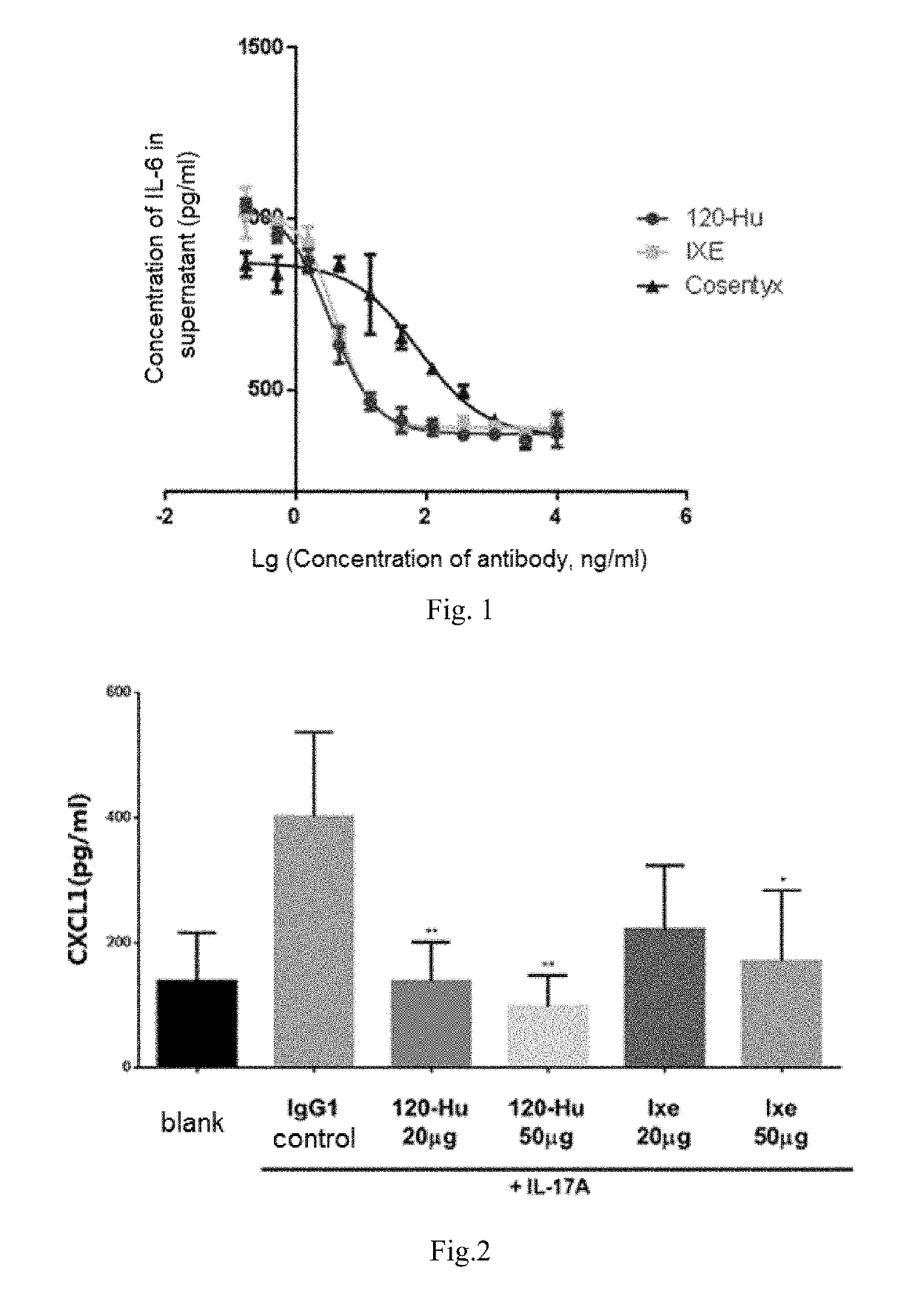Anti-human interleukin-17a monoclonal antibody, and preparation method and use thereof
- Summary
- Abstract
- Description
- Claims
- Application Information
AI Technical Summary
Benefits of technology
Problems solved by technology
Method used
Image
Examples
example 1
Preparation of IL-17A, Seckinumab, Ixekizumab and Soluble-IL-17RA Extracellular Domain
[0054]The sequence of human IL-17A antigen was derived from Pubmed (NM_002190.2). The amino acid sequence of hIL-17A (hIL-17A-his-tag) containing a hexahistidine (his) tag at the C-terminus was supplied to Sangon Biotech company to perform codon optimization according to codon usage preference of Cricetulusgriseus and synthesize the gene fragment, which was then subcloned into the pUC57 vector (derived from Sangon Biotech company) to obtain pUC57-hIL-17A-histag. The hIL-17A-histag fragment was digested from the pUC57-hIL-17A-histag vector using the AvrII and EcoRV cleavage sites and constructed into the pCHO 1.0 expression vector (purchased from Life Technologies company) to obtain pCHO 1.0 (hIL-17A-histag). Then sequencing was performed, and clones with completely correct sequences were selected for transfection.
[0055]The pCHO 1.0 (hIL-17A-his-tag) vector was transfected into the CHO-S cell line (...
example 2
Immunization of IL-17A
[0059]The hIL-17A-histag antigen (50 μg / mouse) was diluted with physiological saline to 75 μl, mixed with an equal volume of Freund's complete adjuvant, fully ultrasonically emulsified, and then administrated to 4-5 weeks old Balb / c mice (purchased from Shanghai Lingchang Biotechnology Co., Ltd., animal production license number: SCXK (Shanghai) 2013-0018) by multipoint subcutaneous injection. Three weeks later, the same amount of protein was also diluted to 75 μl and mixed with an equal volume of Freund's incomplete adjuvant, fully phaco-emulsified, and then administrated to mice by multipoint subcutaneous immunization. Such immunization was repeated two weeks later. All mice were bled by tail to separate serum after one week of the third immunization, and serum titers were detected using an ELISA coated with hIL-17A-histag antigen. For the mice with serum antibody titers >10,000, the following immunization protocol was performed one week after blood collectio...
example 3
Hybridoma Fusion and Screening
[0061]The spleen cells of the mice were taken for fusion three days after the last immunization.
[0062]Sp2 / 0 myeloma cells (derived from the Cell Culture Bank of the Chinese Academy of Sciences) in good condition were cultured in a 37° C., 5% CO2 incubator, and the medium was renewed one day prior to fusion. The fusion and screening process was as follows: Anesthetized mice were sacrificed by cervical dislocation; the spleens of the mice were taken out and ground into debris; spleen cells were collected, washed and counted. The two kinds of cells above mentioned were mixed in a ratio of spleen cells: sp2 / 0 cells=10:1, and centrifuged at 1500 rpm for 7 minutes. The supernatant was discarded. 1 ml of PEG (1450) was added in I minute and the mixture of cells was gently shaken for 90 seconds. 5 ml of serum-free DMEM (purchased from Gibco company) was added in 2.5 minutes, and then additional 5 ml of serum-free medium was added in one time to terminate the PE...
PUM
 Login to View More
Login to View More Abstract
Description
Claims
Application Information
 Login to View More
Login to View More - R&D Engineer
- R&D Manager
- IP Professional
- Industry Leading Data Capabilities
- Powerful AI technology
- Patent DNA Extraction
Browse by: Latest US Patents, China's latest patents, Technical Efficacy Thesaurus, Application Domain, Technology Topic, Popular Technical Reports.
© 2024 PatSnap. All rights reserved.Legal|Privacy policy|Modern Slavery Act Transparency Statement|Sitemap|About US| Contact US: help@patsnap.com








